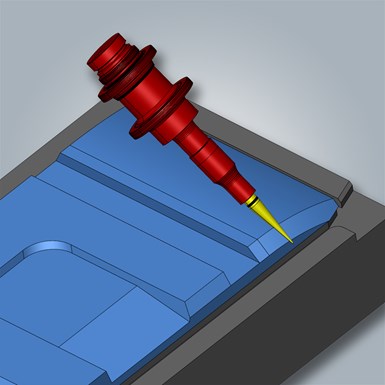Open Mind Technologies leverages ultrasonic knife cutting strategy for composites
HyperMill from Open Mind Technologies utilizes CAM software for ultrasonic knife cutting strategy.

Ultrasonic knife cutting via the hyperMill Virtual Optimizer. Photo Credit: Open Mind Technologies
(Needham, Mass., U.S.), a developer of CAD/CAM software solutions worldwide, offers a precise, highly productive ultrasonic knife cutting strategy via its hyperMill CAM software. Ultrasonic knife cutting is a solution for the efficient cutting of advanced materials, including honeycomb structures, composites and foams often found in aerospace, automotive and wind turbine applications. Using a single interface, users can benefit from the programming capabilities of the hyperMill CAD/CAM software suite ranging from 2.5D machining to five-axis milling. In addition, users are said to be able to easily program ultrasonic cutting with oscillating cutting blades.
hyperMill provides NC code simulation to bring challenging six-axis output to the machine. Using hyperMill’s Virtual Machining Optimizer to control the orientation of the spindle, as the sixth axis, the cutting blade is aligned to the workpiece. The Optimizer keeps toolpaths within limits for demanding machining processes with limited rotation axes, such as a fork-head style milling machine.
“Creating the required six-axis NC programs for knife cutting applications, including five machine axes plus a programmable spindle orientation, has historically proven to be a challenge,” says Alan Levine, managing director of Open Mind Technologies USA Inc. “However, hyperMill provides users with a productive, accurate, safe and smooth cutting solution which prevents hazardous rotations and retract movements.”
Related Content
-
Combining multifunctional thermoplastic composites, additive manufacturing for next-gen airframe structures
The DOMMINIO project combines AFP with 3D printed gyroid cores, embedded SHM sensors and smart materials for induction-driven disassembly of parts at end of life.
-
Sulapac introduces Sulapac Flow 1.7 to replace PLA, ABS and PP in FDM, FGF
Available as filament and granules for extrusion, new wood composite matches properties yet is compostable, eliminates microplastics and reduces carbon footprint.
-
The next evolution in AFP
Automated fiber placement develops into more compact, flexible, modular and digitized systems with multi-material and process capabilities.


